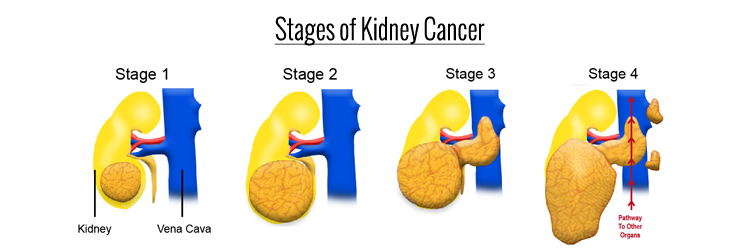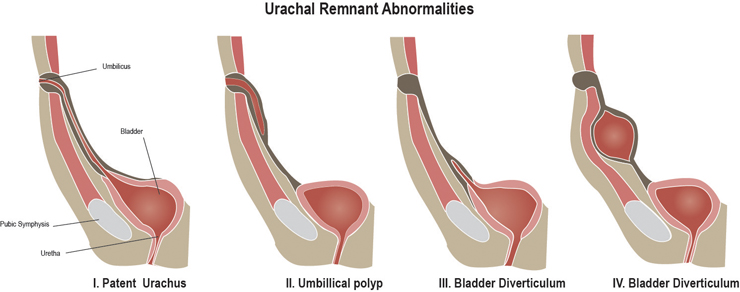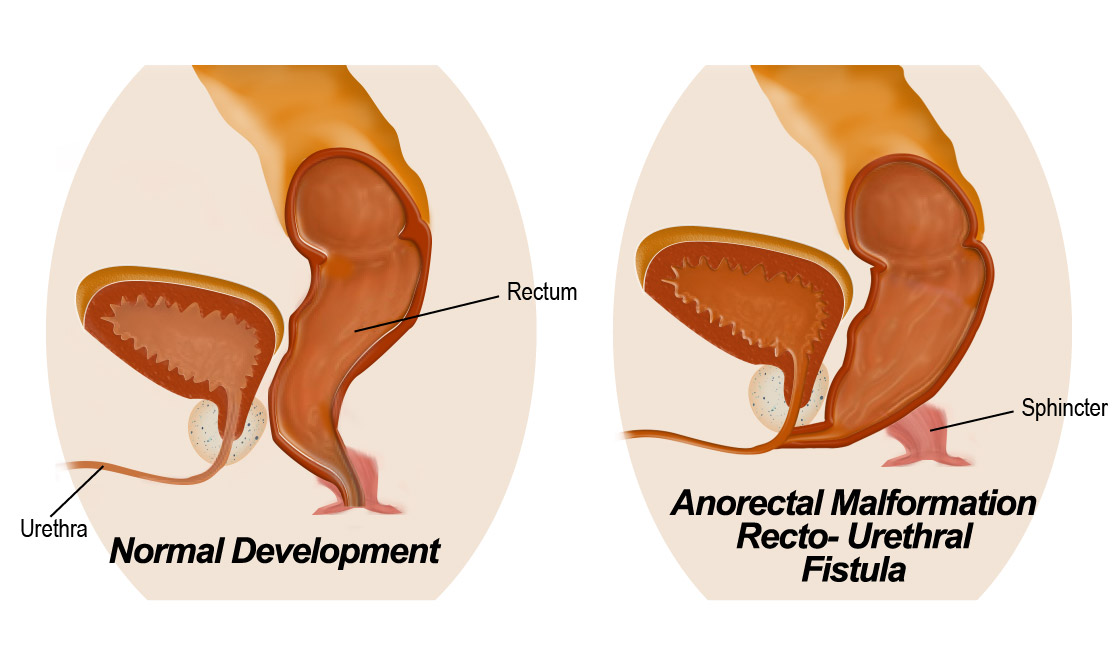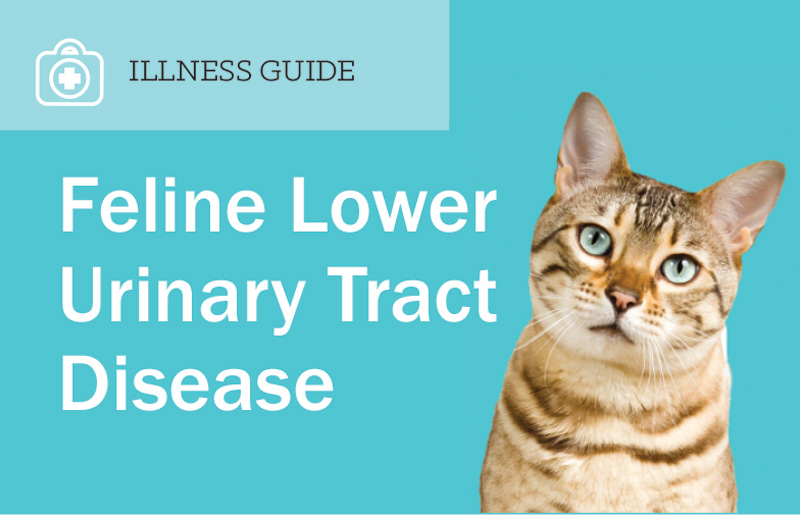
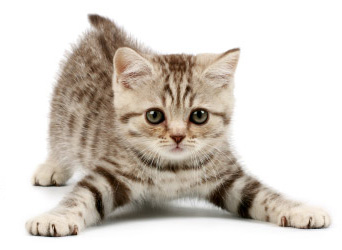 Feline Lower Urinary Tract Disease (FLUTD) is a class of diseases with multiple causes that can profoundly threaten your cat’s health. There are a variety of different conditions described by the term FLUTD- but each is united by its localization to the urinary tract.
Feline Lower Urinary Tract Disease (FLUTD) is a class of diseases with multiple causes that can profoundly threaten your cat’s health. There are a variety of different conditions described by the term FLUTD- but each is united by its localization to the urinary tract.
The urinary tract, or renal system, refers to the organs that eliminate waste from the body and regulate the pressure, volume, composition, pH, and electrolyte and metabolite concentrations of the blood. This system consists of the urethra, bladder, ureters, and kidneys. Though the lower urinary tract generally refers to the bladder and urethra, FLUTD may involve any of the organs in the renal system.
FLUTD affects your cat’s ability to eliminate waste properly, which is an essential function in any mammal. If left untreated, these diseases can be fatal- so it is essential to identify and treat these disorders as quickly as possible. Because FLUTD affects between 1–3% of cats annually and recurs in 50-70% of cases, we have 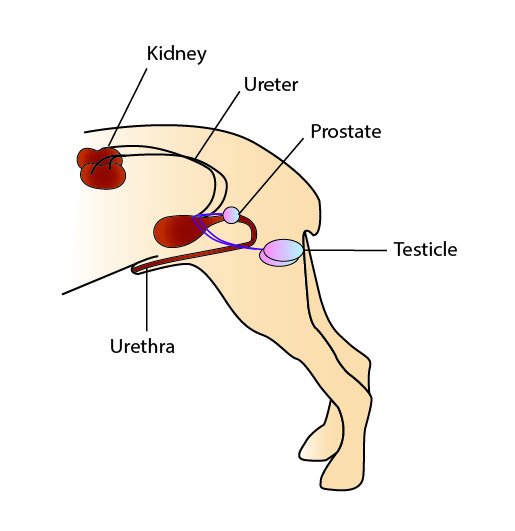 compiled this information to help you understand and prevent or treat this affliction (“Feline idiopathic cystitis (FIC)”, n.d.).
compiled this information to help you understand and prevent or treat this affliction (“Feline idiopathic cystitis (FIC)”, n.d.).
Preventing FLUTD
Most instances of FLUTD can be prevented with routine care for your cat, specifically by feeding your cat only properly formulated wet food. Though some cats may be predisposed to particular afflictions within the scope of the disease, many cats that suffer from FLUTD do so due to environmental stress. Other cats that suffer from rarer instances of this disease can avoid serious complications through specialized routine care.
The standard care that should be provided to any cat to prevent FLUTD diseases includes feeding small meals on a frequent basis as part of a regular daily schedule, ensuring that fresh and clean water is available at all times, and providing an adequate number of clean litter boxes in safe and quiet areas. These concerns should be observed by all cat owners, but they are particularly important for the owners of cats that are male and neutered or cats that are between the ages of 2 and 5 years old (Buffington, Markwell & Smith, 2015).
The ideal diet for a cat to prevent FLUTD is sensitive to their needs as obligate carnivores and to their tendency toward dehydration. Wet diets that are low in carbohydrates and rich in animal proteins are recommended. Certain compounds called glucosaminoglycans (GAGs) can also greatly benefit your cat’s bladder health.
GAGs are used by your pet’s liver to create a mucosal lining that protects the bladder wall from acidic urine. Diets that contain highly bioavailable GAGs, or GAGs that are easily absorbed and utilized by the body, can prevent damage to your cat’s bladder and have also been shown to aid in the dissolution of urinary stones ("Feline lower urinary tract disorder (FLUTD)", n.d.). Another factor to consider when examining the composition of your cat’s diet is the pH of your cat’s food.
Though the formation of certain uroliths, or urinary stones, is tied to dietary magnesium and phosphorus levels, the pH of your cat’s food plays a much more significant factor in urolithiasis. Most experts suggest a diet with a pH between 5.9 and 6.3. This figure, however, may change once urinary stones have formed. Some treatments may aim to increase urine acidity to dissolve the obstruction, while others may require less acidic diets depending on the composition of the obstruction (Buffington et al., 2015).
Additionally, dietary ingredients that are rich in water-soluble constituents have been shown to provide relief from urinary incontinence. Studies in both humans and rats show that pumpkin seeds reduce instances of urinary incontinence by strengthening the pelvic muscles. These seeds contain water-soluble constituents that inhibit aromatase enzymes and facilitate binding to androgen receptors, thus increasing testosterone levels.
An increase in testosterone helps strengthen the pelvic muscles, facilitating healthy urination. Though pumpkin seeds themselves may not be the healthiest addition to your cat's diet, supplements or diets that include their water-soluble constituents may be especially helpful for cats that have been neutered, as these cats typically experience a decrease in testosterone levels that may weaken pelvic floor and sphincter muscles (Faloon, 2008).
Identifying FLUTD
As FLUTD is actually an assortment of related diseases, the symptoms for each incidence will vary; however, each case of FLUTD is characterized by a common set of symptoms. These symptoms indicate that there is a problem with your cat’s lower urinary tract and that you should bring him or her to a veterinarian’s office for further diagnosis. They include:
- Difficulty urinating
- Frequent or prolonged urination
- Crying out while urinating
- Excessive licking of the genitals
- Inappropriate marking or elimination
- Bloody urine
Though these signs are universal across the various types of FLUTD, additional symptoms can help narrow down the identity of the specific affliction affecting your pet. Conditions included within the scope of FLUTD can range anywhere from a urinary tract infection to any of several types of cancer. The divergent nature of this disease means that it may take several tests before a definite diagnosis can be given.
In most cases, the first methods of diagnosis that will be employed by your veterinarian are a physical examination and urinalysis. Following these tests, your veterinarian may run x-rays, ultrasounds, blood work, or bacterial cultures to assess the specific problem affecting your cat. The final results of these examinations will also determine the method of treatment your veterinarian will implement for your pet.
Though there are a large number of diseases that can affect your cat’s urinary tract- each disease can be grouped into one of five classes of conditions: urinary tract infection, urethral obstruction, cancer, anatomical defects, or idiopathic cystitis.
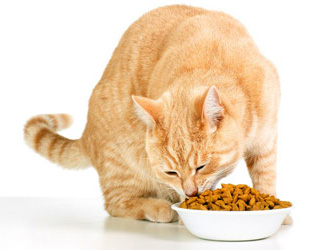 Approximately two thirds of FLUTD cases have no known underlying cause; these cases are diagnosed as feline idiopathic cystitis (FIC). Most cases of FIC involve issues with the bladder; however, recent research on the topic hints that complex irregularities in the nervous and endocrine systems are also currently included in the scope of FIC. Some cases of FIC have been linked to the gastrointestinal, cardiovascular, respiratory, and immune systems as well (Westropp & Buffington, 2004). Due to the broad scope of this disease, Buffington (2011) considers FIC to be part of a larger class of problems known as Pandora Syndrome.
Approximately two thirds of FLUTD cases have no known underlying cause; these cases are diagnosed as feline idiopathic cystitis (FIC). Most cases of FIC involve issues with the bladder; however, recent research on the topic hints that complex irregularities in the nervous and endocrine systems are also currently included in the scope of FIC. Some cases of FIC have been linked to the gastrointestinal, cardiovascular, respiratory, and immune systems as well (Westropp & Buffington, 2004). Due to the broad scope of this disease, Buffington (2011) considers FIC to be part of a larger class of problems known as Pandora Syndrome.
Symptoms
The principle factors that define cases of FIC are inflammation and diminished defenses in the lower urinary tract. These factors manifest as thickened bladder walls, pain localized to the bladder, and bloody urine. These factors only point to FIC when there is also a lack of any anatomic abnormalities, bacterial infections, or obstructions of the urinary tract, as the term is a broad category for cats suffering from symptoms of FLUTD that do not suffer from one of its four central diseases.
Aside from bloody urination, pain is typically recognizable through urination outside of the litter box or excessive grooming around the afflicted area. Symptoms of this disease typically subside without treatment within five to ten days of their initial onset. Though the symptoms may subside, they are likely to recur at irregular intervals; in severe cases, they may recur more often and persist for longer periods (“Feline idiopathic cystitis (FIC)”, n.d.).
Causes
One common factor among a majority of cases of FIC is stress from environmental factors, with controlled studies showing that more than 70 percent of cats diagnosed with FIC respond positively to placebo treatments. The study also showed that cats can benefit greatly from an enriched environment. Cats with a regular playtime, a stationary litter box, and a regular feeding time experienced a reduction of symptoms by up to 80 percent (Stella, Linda, & Buffington, 2011).
Because these symptoms can be isolated from the other diseases of FLUTD, it stands to reason that these same factors may also worsen cases in which one of the four diseases is actually present. Therefore, even when a cat suffers from infection, cancer, anatomical defects or injury, or urethral blockage or stones- it is recommended to provide the care ascribed to cats with FIC.
Treatment
As stated, many cases of FIC will improve with certain basic changes to a cat’s environment. These changes include ensuring that cats have a safe and large open space, a regular schedule of diet and play, clean litter boxes in convenient locations, and a comfortable social atmosphere both with humans and other cats in the household. Other treatments include using feline facial pheromones to calm distressed cats and drug therapy either to relieve pain or to further reduce stress. According to Becker (2014), calming a cat’s owner can also help relieve a cat’s symptoms.
When improving your cat’s environment, it can be useful to remember that a stable routine is extremely important to cats. Healthy cats will often develop behaviors associated with illness if their routines are altered. In addition to the symptoms of FIC, these behaviors may include vomiting, avoiding the litter box and refusing to eat.
While providing consistent meals can aid with the treatment in FIC, certain dietary changes can have an even larger impact on your cat’s urinary health. Providing a diet that is rich in glycosaminoglycans (GAGs) can help improve bladder health, as GAGs compose the mucosal layer that lines the bladder wall. This layer is essential to your cat's renal health, as it serves to protect the bladder from highly acidic urine (“Feline idiopathic cystitis (FIC)”, n.d.).
GAGs are commonly used in joint supplements, as they also compose the cartilage used to connect joints. Glucosamine, chondroitin, and hyaluronic acid are some GAGs commonly included in pet foods, treats, and supplements. Finding food formulas, supplements and treats that include these ingredients may help to support your cat’s urinary tract.
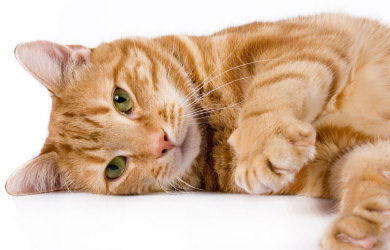 Urinary tract infections (UTIs) are bacterial infections that generally only affect older cats. Microbes can damage the cells of the urinary tract making urination both painful and difficult. An infection may affect any part of the urinary tract from the kidneys to the urethra. Pyelonephritis, or infection of the kidney, can lead to acute and chronic kidney disease- so it is imperative to treat UTIs promptly (Pierson, 2013).
Urinary tract infections (UTIs) are bacterial infections that generally only affect older cats. Microbes can damage the cells of the urinary tract making urination both painful and difficult. An infection may affect any part of the urinary tract from the kidneys to the urethra. Pyelonephritis, or infection of the kidney, can lead to acute and chronic kidney disease- so it is imperative to treat UTIs promptly (Pierson, 2013).
Symptoms of Urinary Tract Infections in Cats
In addition to the aforementioned general FLUTD symptoms, cats suffering from a urinary tract infection may drink a larger amount of water than normal and suffer from incontinence- or an inability to control their urination. If there is a diminished flow of urine- it is likely that there is some obstruction afflicting your cat as well. Cats exhibiting these symptoms demand immediate treatment. To diagnose an infection, your veterinarian will need to analyze a urine sample.
Equally as important as prompt treatment, an accurate confirmation of infection is absolutely necessary; your veterinarian must be careful to not prescribe antibiotics without a definitive diagnosis, so as not to increase the risk of future infections. A complete urinalysis is required to confirm that a cat's condition is indeed caused by an infection. A complete urinalysis entails more than simple sediment analysis, which is the most common method of urinalysis employed by veterinarians. Procedures known as urine-specific gravity and urine glucose level determination are needed to attain enough data to evaluate a suspected infection (Weese et al., 2011).
According to Weese (2011), an aerobic bacterial culture and susceptibility should also be performed to confirm the presence of an infection. Your veterinarian may also perform blood tests and other examinations to determine if your cat is suffering from any additional disease that may be complicating your cat’s infection or otherwise causing your cat’s symptoms.
Causes
Bacterial infections generally occur when bacteria has traveled up through the urethra from the cat’s environment. In most cases, the acidity of a cat’s urine creates a sufficiently hostile environment to bacteria to prevent infections from occuring. Because of this, in otherwise healthy cats, infections only constitute 1-2% of FLUTD cases; however, Pierson notes (2011) that diseases that reduce the acidity of a cat’s urine, such as chronic kidney disease (CKD), hyperthyroidism, or diabetes can increase the risk of infection.
Treatment
Because of the rarity of UTIs- when the term is used to refer to infections as opposed to irritation of the urinary tract- it is imperative that you remain vigilant when seeking treatment. Even in the veterinary field today, it’s not uncommon for antibiotics to be abused when the urinary tract is irritated. In actuality, this treatment should be reserved for cats that have been confirmed to be suffering from an infection or cats that are recovering from surgery (“Urinary Tract Infection in Cats – Causes, Symptoms & Treatment | Cat Health Collection”, 2009).
Most treatments for urinary tract infections aim at relieving the symptoms and discomfort caused by the infection while simultaneously targeting the microbes causing it. A UTI is actually very simple to treat relative to other urinary tract problems; unfortunately, when a urinary tract problem is affecting your cat there is a very low chance that the problem is actually an infection.
While treating a UTI, it can be useful to make changes to your cat’s diet and habitat to prevent recurring infections. Regularly cleaning your cat’s litter box may reduce the chance of bacteria accessing your cat’s urinary tract, while a diet that increases urine acidity may create an environment that is inhospitable for bacteria; however, an excessively acidic urine pH can also prove detrimental to the well-being of your cat.
In addition to antibiotics and regulating urine pH, a natural sugar called D-mannose is also known to help fight urinary tract infections in humans and is recommended by Becker (2010) to fight infections in cats. This natural sugar has antibiotic properties that can help void the urinary tract of bacteria. When included in your cat's diet, the sugar is excreted by the kidneys into the bladder where bacteria attach to it and are then easily and painlessly voided from the bladder.
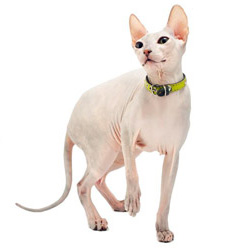 One of the most serious cases of FLUTD, urethral obstruction, can put your cat’s life in serious danger. The severity of your cat’s condition is dependent on how much of the urethra is actually obstructed, the cause of the obstruction, and your cat’s overall health. Male cats are more likely to suffer from this condition because they have a longer, narrower urethra than female cats.
One of the most serious cases of FLUTD, urethral obstruction, can put your cat’s life in serious danger. The severity of your cat’s condition is dependent on how much of the urethra is actually obstructed, the cause of the obstruction, and your cat’s overall health. Male cats are more likely to suffer from this condition because they have a longer, narrower urethra than female cats.
If the urethra is partially obstructed- the symptoms of FLUTD will aptly describe what your cat will experience; however, if the urethra is completely obstructed then the resulting effects will be much more pronounced. The shift between a partial and a complete obstruction can happen suddenly and is vital to recognize for all cat owners due to the dangers a complete obstruction poses.
In cases of total obstruction, the material blocking the urethra makes it impossible for the kidneys to filter toxins from the blood. In this case, it is essential to seek emergency medical treatment for your cat, as the resulting imbalances can cause death within two days. Generally, when a full obstruction occurs, cats will exhibit more signs of pain that reveal the severity of their condition through audible cries.
The method of treating urinary obstruction varies depending on the type of material blocking the urethra. In many cases, the obstruction is composed of minerals that have formed hard stones or soft plugs in your cat’s urinary tract. These obstructions can be caused by the accumulation of any of several types of minerals; depending on the composition of an obstruction, it can be treated in a variety of ways. According to Brown (2013), the composition of the most common obstructions are listed below:
| Mineral Name | Chemical Formula | Chemical Name |
|---|---|---|
| Struvite | MgNH4PO4·6H20 | Magnesium ammonium phosphate hexahydrate |
| Urate | C5H4N4O3 | Urate |
| Calcium Oxalate | CaC2O4 | Calcium ethanedioate |
| Cystine | (SCH2CHNH2>COOH)2 | Cystine |
Of these crystals, the three most common crystals to contribute to an obstruction include struvite, oxalate, and urate. These minerals can mix to form urethral plugs and urinary stones of varying size and consistency. Some materials are softer and easier to break apart or pass, while others are too solid to pass and require surgery to remove. Struvite stones can generally be dissolved before they cause a serious obstruction- while oxalate and urate stones tend to require more advanced procedures.
Two procedures used to remove urinary stones in cats are a cystotomy, a surgery that entails opening the bladder to allow for the direct removal of the obstruction, and urohydropropulsion, in which a catheter is used to flush out the bladder with a saline solution. In any event, it’s likely that obstructions will recur in cats that have developed them; therefore, it’s important to take precautionary measures to prevent the formation of a second obstruction after either procedure.
Struvite & Urate Stones
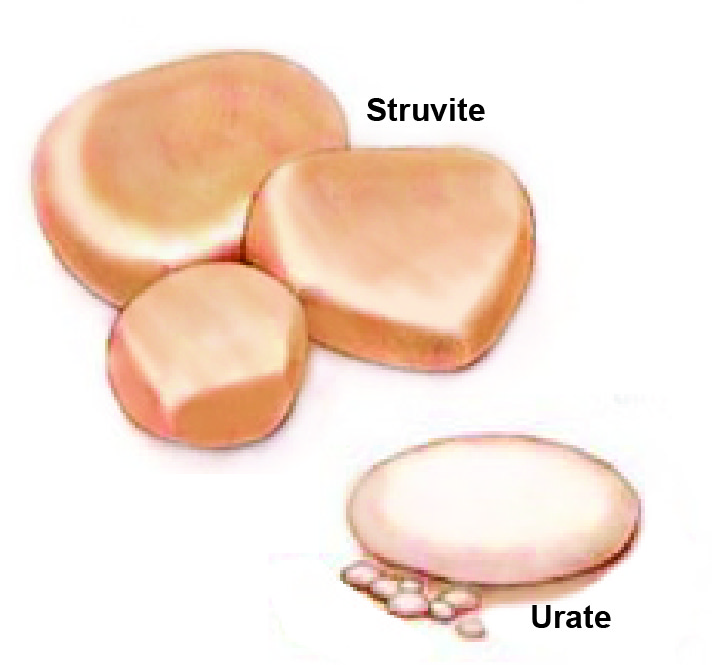
Certain changes to your cat’s dietary habits can be crucial in the preventing the formation of urinary stones. Because each type of stone has a different mineral composition, the dietary requirements for preventing or treating each type of stone is different. For instance, in cases where struvite stones are not currently obstructing the urethra, specially formulated diets that increase the acidity of your cat's urine can help dissolve the obstruction. Once the stone is obstructing the kidney, however, it must be removed.
To prevent each stone from forming, controlling the pH of your pet’s urine can become a routine task. In her UC Davis Veterinary Medicine protocol for treating urate urolithiasis in dogs and cats, Westropp (n.d.) recommends ensuring that your pet’s urine remains acidic, meaning that its pH level stays at 6 or below. By restricting protein, phosphorous, and magnesium, a specialized diet can compensate for the kidney, which would normally filter these out of your pet’s blood.
Urate stones are rare in cats and the subtleties of their formation are still largely a mystery. There are, however, established methods of preventing and dissolving these stones. Unlike struvite stones, the best way to dissolve urate stones is to increase the pH of your cat’s urine to make it more basic, resulting in a pH greater than 7. This process reduces the amount of ammonia produced by the renal system.
Westropp (n.d.) also recommends feeding your cat a moist diet that is low in protein to reduce the amount of urate in the urine relative to other compounds. This diet can also be imperative in the effort to prevent future urate stones from forming.
Calcium Oxalate & Cystine Stones
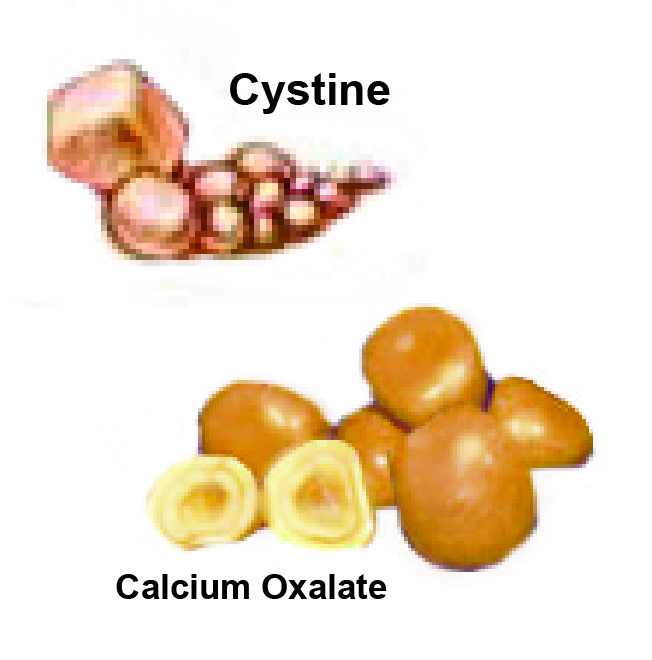
Unlike struvite and urate stones, calcium oxalate and cystine stones cannot be dissolved- only prevented; and as with urate stones, slightly more basic urine is desired for preventing oxalate uroliths. Diets with potassium citrate help keep the pH balance at the desired level, in a range between 6.5 and 7.5. It can also help to ensure your cat consumes an adequate amount of water.
Cystine uroliths are rare in cats- but there are protocols for their dissolution and prevention. To dissolve these stones, there is no method that is guaranteed to work- but it is suggested that you attempt to increase the pH of your cat’s urine until it is more than 7 such that the urine is basic. This can also help prevent future cystine stones from forming.
Though Pierson (2013) cautions against performing the procedure prematuerly, a perineal urethrostomy can prevent future obstructions from forming. This surgery entails removing the narrow part of the urethra as well as a large portion of the penis for male cats. The result is a wider opening that allows for a less obstructed tract. It’s important to note, however, that this procedure should be used only as a last resort, as it can cause urinary incontinence and other bladder diseases. Additionally, patients can expect bleeding for up to ten days after the surgery.
 Urinary tract cancer is rare in cats, affecting only 1-5% of cats diagnosed with FLUTD; however, it can be life-threatening to those diagnosed. There are multiple types of cancer that may afflict your cat’s renal system, each of which requires different treatment.
Urinary tract cancer is rare in cats, affecting only 1-5% of cats diagnosed with FLUTD; however, it can be life-threatening to those diagnosed. There are multiple types of cancer that may afflict your cat’s renal system, each of which requires different treatment.
Symptoms
In addition to the typical symptoms of FLUTD, cats suffering from cancer might exhibit an inability to urinate. X-rays, ultrasound, and urinalysis may help to detect tumors in pets exhibiting these symptoms. For a definitive diagnosis, a histopathology- or microscopic examination of stained tissue- should be performed. A histopathology report will give a comprehensive prognosis when combined with the type, location, and differentiation (or appearance) of a tumor.
Causes
Cancer has many causes and it can be difficult to determine an exact catalyst to its inception and proliferation; some external factors that are known to contribute to cancer include radiation, chemicals, hormones and infections. Each of these possible factors has the potential to alter the genetic regulation of cells; these genetic alterations prevent the genes from regulating cell death, causing the unnatural growth of tissue. Congenital abnormalities in which an organ’s cellular structure develops in an atypical manner before birth can also cause cancer to develop.
Cancer is more likely to occur when cells are rapidly expanding, as is the case in the formation of organs. One type of cancer, nephroblastoma, develops as a result of abnormal kidney tissue growth while in the womb. Renal nephroblastoma in cats is uncommon but highly malignant, often spreading to the lungs and liver. This type of cancer is generally diagnosed within the first year of a cat’s life and is graded as favorable or unfavorable as determined by a histology report.
The College of Veterinary Medicine at Cornell University (2014) suggests that urinary tract cancer may be caused or complicated by either the feline leukemia virus (FeLV) or the Feline Immunodeficiency Virus (FIV). Both FIV and FeLV are retroviruses, meaning that the way that they replicate is more likely to cause mutations, which makes them difficult to treat. As the name implies, FeLV tends to affect bone marrow first before metastasizing to other areas, such as the urinary tract.
By contrast, FIV suppresses a cat’s immune response, increasing the likelihood that the cat will develop lymphoma. In fact, for cats, lymphoma is the most common type of tumor found in the kidneys. This being said, Rest (n.d.) notes that renal lymphoma is indicative of a widespread cancer that is not treatable save to improve the comfort and quality of life of an infected cat. Bladder tumors, on the other hand, affect the lower urinary tract in a variety of ways depending on their stage of development.
Rhabdomyosarcoma of the bladder can start off as benign papillomas that are considered to be superficial cancers. Papillary carcinomas occur on the surface of the bladder and can be easily removed with transurethral resection, an operation in which cancerous tissue is removed through a cystoscope- which is a hollow tube equipped with a lens (“Renal Tumors – Feline”, n.d.).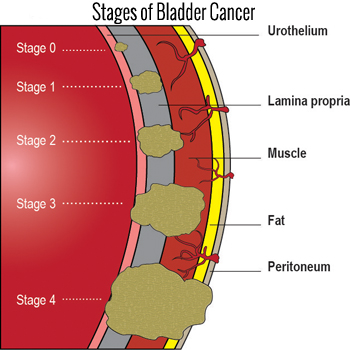 Carcinoma in situ (CIS), however, is another type of “superficial bladder cancer” that is more likely to become invasive due to its aggressive growth pattern. In spite of its name, these cancers- considered “stage 0” bladder cancer- are indicative of serious danger, as 25% of patients treated for superficial bladder cancer inevitably die from bladder cancer (“Bladder Cancer”, 2014).
Carcinoma in situ (CIS), however, is another type of “superficial bladder cancer” that is more likely to become invasive due to its aggressive growth pattern. In spite of its name, these cancers- considered “stage 0” bladder cancer- are indicative of serious danger, as 25% of patients treated for superficial bladder cancer inevitably die from bladder cancer (“Bladder Cancer”, 2014).
Stage 1 bladder cancer is also considered a superficial form, as it differs from stage 0 only in the cancer’s penetration into the connective tissue. This stage still indicates that the cancer has yet to progress into the muscle tissue or the lymph nodes. It’s the progression from stage 1 cancer to stage 2 marks the advancement of its classification from “superficial” to “deep” or “invasive”. Stage 2, specifically, refers to the cancer’s progression into the muscle wall.
Stage 2 cancer extends through the cancer’s spread into the deep muscle tissue; however, once it metastasizes to the local area outside of the bladder, it is reclassified as stage 3. Patients with stage 3 bladder cancer still have their cancer localized to the area just outside the bladder. Once it spreads to the pelvis, lymph nodes, or other distant sites, the cancer has advanced to stage 4. Pets that have experienced any of these stages of cancer may also experience recurrent bladder cancer, in which the cancer returns after treatment (“Bladder Cancer”, 2014).
Treatment
It’s very rare that cancer will subside without treatment and tumors are not easily combated by your pet’s immune response. There are multiple things that should be done to treat cancer in cats, including the surgical removal of tumors, radiation therapy, and chemotherapy. In addition to surgery, it can be important to help your pet with pain management and it is absolutely vital that you offer a diet with the proper nutrition.
Different forms of cancer cause different levels of pain and treatments for cancer can cause pain as well. Mild or moderate pain is generally treated with non-opioid analgesics, which include nonsteroidal anti-inflammatory drugs (NSAIDs) like ibuprofen or aspirin. Different strengths of opioids are used to treat more severe pain- these drugs include codeine, tramadol, and morphine. Local anesthetic may also be used be for overwhelming pain caused by tumors or by cancer treatments (“Pain Management for Cats and Dogs with Cancer”, 2015).
Though select NSAIDs such as meloxicam and carprofen are approved for use in cats, most of these drugs operate by inhibiting one of three enzymes: cyclo-oxygenase-1, cyclo-oxygenase-2, or 5-lipoxygenase. The aforementioned drugs are cyclo-oxygenase-2 (COX-2) inhibitors respectively recommended for treating postsurgical pain and musculoskeletal pain in cats; though this mechanism of action is known to cause fewer adverse reactions than other NSAIDs, its use is still associated with adverse effects to the renal system.
Due to these adverse effects, Dr. Karen Becker (2010) strongly discourages the use of meloxicam and similar drugs in cats. On the other hand, a collaborative enterprise to create international standard guidelines for the use of NSAIDs pioneered by the International Society of Feline Medicine (ISFM) and the American Association of Feline Practitioners (AAFP) state that these renal problems “should not be a reason for withholding analgesic therapy when it is indicated.” (Sparkes et al., 2010).
This being said, both parties agree that another pain relief option should be administered if available. Becker (2010) recommends looking into the viability of Adequan injections as a method of pain relief for your cat. In cats suffering from renal or urinary tract distress, Adequan, being composed of polysulfated glucosaminoglycans, provides the added potential benefit of supporting a healthy bladder by contributing the raw components used to construct and maintain its protective mucosal lining.
Additionally, comfortable bedding, physical therapy, and acupuncture, and dietary supplements can all be used to reduce pain. Dietary supplements and proper nutrition are not only beneficial for managing your pet’s pain- but they also serve to combat the debilitating effects of cancer and cancer treatments. In fact, because cats with cancer often suffer from malnutrition and weight loss, proper nutrition is particularly important.
Though cancer itself may inhibit the absorption of nutrients and the appetite of the afflicted cat- some cancer treatments can cause nausea, vomiting, or inflammation that may further exacerbate the problem. This can sometimes require the cessation of particular treatments as the malnutrition caused by cancer in conjunction with these effects can prove fatal to your cat.
This severe weight loss, or cachexia, is caused by an alteration to your pet’s metabolism. Cancer can alter the way your pet absorbs proteins, sugars, fats, and other nutrients. These changes cause your pet to metabolize his own fat and muscle in order to meet his energy needs. Surgery and similar treatments also increase the energy expenditure of your pet, requiring a special diet. Enteral dietary therapy is often used to combat cancer cachexia, as using a feeding tube is a cost-effective way to ensure that your pet absorbs nutrients effectively (Ogilvie, n.d.).
The best way to treat cancer cachexia is to prevent it. This entails beginning a special diet as soon as possible. Ogilvie (n.d.) recommends choosing food that is low in simple carbohydrates and high in both protein and fiber. Food for cats at-risk for cachexia should include a moderate amount of fats and antioxidants as well. Each case of cancer cachexia varies, so it’s important to consult your veterinarian when forming your cat’s diet.
When your cat’s cancer is localized to one area or a single tumor, the cancerous cells can often be surgically removed. If at all possible, the tumor should be removed without affecting other parts of your cat; however, in certain cases, it may be necessary to remove an entire organ from your cat in order to eliminate the cancerous cells. This is recommended in cases where a single kidney is afflicted, as it would be ideal to eliminate the cancer before it can spread to the healthy kidney. There is no curative treatment for bilateral kidney cancer. Bladder tumors can be removed surgically, although cancer generally metastasizes to other parts of the body before bladder cancer is diagnosed.
Radiation therapy, in which gamma rays are used to damage the DNA of cancerous cells to prevent mitosis, is generally used to either shrink a tumor before surgery or to eliminate cancerous cells that remain in your pet’s body post-surgery. Though this method of treating cancer can be extremely effective, Linderman and colleagues (n.d.) warn that the treatment can also kill healthy cells and may take a toll on your pet’s well-being.
Radiation can also be used in combination with chemotherapy, which is more effective at eliminating cells that have evaded surgical removal. Chemotherapy is the use of drugs to control cancer; it’s generally recommended that no other medications are administered concurrently with those used for chemotherapy. Though most chemotherapy drugs are administered intravenously, some can be given orally or injected directly into the tumor. Chemotherapy can also be used to improve your pet’s quality of life in instances where surgical removal is no longer an option.
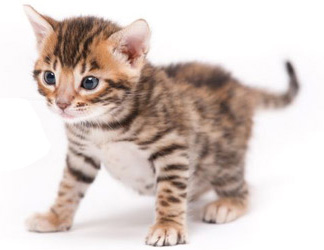 Anatomical defects can considerably hamper the functionality of your cat’s lower urinary tract. Abnormalities can affect the kidneys, ureters, bladder, and urethra of a pet. These issues can be inherited genetically or produced as a result of injury or disease in the womb. Though very rare, these defects may have a tremendous impact on your cat’s health either straight from birth or later in life.
Anatomical defects can considerably hamper the functionality of your cat’s lower urinary tract. Abnormalities can affect the kidneys, ureters, bladder, and urethra of a pet. These issues can be inherited genetically or produced as a result of injury or disease in the womb. Though very rare, these defects may have a tremendous impact on your cat’s health either straight from birth or later in life.
Kidneys
Irregular development may lead to organs that are malformed, misplaced, damaged, underdeveloped, or completely undeveloped. Kidneys are susceptible to each of these problems, though abnormal development is rare. Kidney malformations, or dysplasias, have no known effective treatment aside from managing symptoms associated with the problem. Cats with hypoplasia suffer from irregularly small kidneys and typically experience vomiting, inappetence, and increased thirst and urination. In their manual on congenital disorders, Fitzgerald and his cohorts (2011) stated that these symptoms typically affect hypoplastic kittens when they are between 6 months and 2 years of age.
Kittens may also be born with cysts in their kidneys. A single cyst generally won’t interfere with kidney function, but polycystic kidneys can lead to progressive kidney failure and are generally the result of an inherited disorder known as polycistic kidney disease. The disease is connected to a genetic predisposition found in Persian cats and related breeds, but its development is also tied to environmental factors and a hormonal imbalance.
Cats with this disease generally have large kidneys that can be identified with a physical examination from your veterinarian. Aside from the enlarged organ, not many symptoms are exhibited in early stages of the disease. Most renal cysts are not painful, but the cysts can lead to bacterial infection and possibly sepsis, which is potentially life-threatening. If your doctor notices a swollen abdomen and suspects polycystic kidney disease as the culprit, he may perform abdominal ultrasounds and urinalysis (“Kidney Disease Caused by Multiple Cysts in Cats”, 2013).
A cat diagnosed with polycystic kidneys will require periodic removal of fluid from their cysts to reduce each cyst’s volume and to stave off bacterial infection. Once infected, cats should be tested routinely (every 2 to 6 months) to determine their levels of electrolytes, potassium, calcium, and nitrogen to assess whether or not they are developing related kidney diseases. There is no known cure for cysts and the current procedure for prevention is limited to selective breeding practices (“Polycistic Kidney Disease (PKD) in Persian Cats”, 2013).
Cats that exhibit symptoms of polycystic kidneys but that are not diagnosed with polycystic kidney disease may be experiencing the effects of kidney cancer. Other problems that may affect your cat include incorrectly positioned kidneys or kidneys that are fused together. A kitten’s kidneys may also completely fail to develop. If one kidney fails to develop then the kitten will generally mature normally without problem- but if both kidneys do not develop then the kitten will not survive long after birth.
Bladder
The bladder is responsible for storing your pet’s urine and can be affected by several abnormalities with the most common being urachal remnants. The urachus is a structure in prenatal kittens that connects the bladder to the umbilicus duct, allowing for the disposal of urine while the kitten is in the womb. Goel and Weerakkody (2014) break down urachal remnant abonormalities into four principal categories: patent urachus, urachal cyst, urachal-umbilical sinus, and vesicourachal diverticulum.
For most kittens, the urachus disappears after birth; in rare cases, the urachal canal between the bladder and navel does not close. When the urachal canal remains open, the condition is known as patent urachus and can lead to urine leaking either into your cat’s abdominal cavity or our from the navel. In a resource article for The University of Sydney, Fong (2014) states that the former will result in vomiting, depression, excessive thirst, and dehydration; the latter will cause persistent moisture around the navel that can lead to a skin infection.
Both forms of patent urachus can be treated with surgical removal of the urachus to prevent further leakage and associated problems. Though patent urachus is by far the most common abnormality affecting the urachus, the tube can also become affected by cysts or it can fail to close either at the bladder or the umbilical end. These conditions cause incontinence, urine scalding, and urinary tract infections; each condition can be diagnosed via ultrasound and treated with simple surgery (Linderman, Post & McDaniel, n.d.).
Other abnormalities that can affect the bladder include irregular development such that a pet winds up with multiple bladders, an underdeveloped bladder, or a bladder that is turned inside out. The bladder may also fail to develop completely, a defect that will prove fatal. Though it is less common in cats than in dogs, both genders of cats may suffer from posterior displacement of the bladder.
This displacement, or pelvic bladder, can result in urinary incontinence, urine scalding, and an inability to urinate. As with other bladder abnormalities, this problem will likely require extensive testing for a definitive diagnosis. Your veterinarian may use a complete blood count, a biochemistry profile, urinalysis, abdominal X-rays, or ultrasounds to determine exactly what is wrong with your pet’s bladder. A displaced bladder will require corrective surgery to reposition both the bladder and the urethra. Most conditions affecting the bladder will also require the use of antibiotics to treat related infections.
Ureters
Each of your pet’s two kidneys is connected to the bladder by a ureter; however, in very rare occasions, cats can suffer from an abnormality in which a ureter connects straight to the urethra, uterus, or vagina. In these cases, the flow of urine is not regulated properly and infection and other complications might occur. This ectopic ureter can also lead to an enlarged kidney and problems with your pet’s urethral sphincter (Fitzgerald, Bartges, Brown, Sanderson & Wallace, 2011).
If your veterinarian suspects your cat has an ectopic ureter then a urethrocystoscopy, in which a tube with a camera is inserted into the urethra, will help give a definitive diagnosis. If the diagnosis is confirmed, your veterinarian may surgically create a new ureteral opening or remove the ureter and its corresponding bladder entirely (“Urethral Shaft Abnormality in Cats, n.d.).
If these problems are not the result of an ectopic ureter then an underdeveloped ureter, an additional ureter, or an enlarged ureter may be the cause of your cat’s distress. These conditions can also generally be treated with surgery. If removing the ureter and kidney is not an option, it is possible to use colposuspension, a technique in which the bladder is moved by attaching it with stitches to the pubic bone or nearby cartilage, to fix the problem. WebMd's Urinary Incontinence Health Center (2012) also recommends that your vet prescribe alpha-blockers or tricyclic antidepressors as an alternate solution to enhance your pet’s urinary flow.
Urethra
The urethra is essential for the elimination of urine in your cat. Though congenital problems with the urethra are rare in cats, it may suffer from any of several abnormalities. The urethra may not develop fully such that it does not open properly- or at all. It’s also possible for a cat to develop multiple urethras or to suffer from a misplaced urethra. The tube may also be damaged, whether this means a cystic urethra or one with a misplaced opening or hole.
Abnormal openings in the urinary tract are known as fistulas. These openings cause incontinence, irritation throughout the lower urinary tract, frequent urinary tract infections, diarrhea, fever, weight loss, nausea, vomiting, abdominal pain, and fluid drainage. Your veterinarian will likely run the tests mentioned throughout this article, though they may also use a radionuclide cystogram, a computed tomography scan, and retrograde pyelography to verify the diagnosis.
Both radionuclide cystograms and retrograde pyelography entail inserting a solution into your pet’s lower urinary tract to more easily view your pet’s organs in certain scans; a computed tomography, or CT, scan refers to the use of multiple X-rays to create a view of a cross-section of the body. Initial treatment for small fistulas may include catheter drainage; however, most fistulas require surgical repair and antibiotics to treat (“Urinary or Fecal Fistula”, 2014).
Becker, K. (2014, February 21). Feline Idiopathic Cystitis: More Than a Bladder Problem. Retrieved September 9, 2014, from https://healthypets.mercola.com/sites/healthypets/archive/2014/02/21/feline-lower-urinary-tract-disease.aspx
Becker, K. (2010, November 30). Metacam: This Popular Pain Management Drug Causes Kidney Failure in Cats. Retrieved May 5, 2015, from https://healthypets.mercola.com/sites/healthypets/archive/2010/11/30/meloxicam-metacam-cause-renal-failure-for-pet-cats.aspx
Becker, K. (2010, January 6). Urinary Tract Infection: Eliminate The #1 Reason Cats Go to the Vet. Retrieved April 23, 2015, from https://healthypets.mercola.com/sites/healthypets/archive/2010/01/06/prevent-urinary-tract-infection-in-cats.aspx
Bladder Cancer. (2014, January 1). Retrieved August 12, 2014, from https://www.texasoncology.com/types-of-cancer/bladder-cancer/
Brown, S. (2013, October 1). Urolithiasis in Small Animals. Retrieved August 7, 2014, from https://www.merckvetmanual.com/pethealth/cat_disorders_and_diseases/kidney_and_urinary_tract_disorders_of_cats/congenital_and_inherited_disorders_of_the_urinary_system_of_cats.html
Buffington, T. Pandora syndrome: Rethinking our approach to idiopathic cystitis in cats (2011, October 1). Retrieved January 27, 2015 from https://veterinarymedicine.dvm360.com/pandora-syndrome-rethinking-our-approach-idiopathic-cystitis-cats
Buffington, T., Markwell, P., Smith, B.. (2015) The Effect of Diet on Lower Urinary Tract Disease in Cats. Retrieved January 20, 2015, from https://jn.nutrition.org/content/128/12/2753S.long
College of Veterinary Medicine - Cornell University. (2014, January 1). Retrieved August 28, 2014, from https://www.vet.cornell.edu/FHC/health_resources/brochure_felv.cfm
Faloon, W. (2008, November 1). A Breakthrough in the Relief of Overactive Bladder and Urinary Incontinence. Retrieved April 2, 2015, from https://www.lef.org/magazine/2008/11/Pumpkin-Seed-Relieves-Overactive-Bladder-Urinary-Incontinence/Page-01
Feline lower urinary tract disease (FLUTD). (n.d.). Retrieved April 23, 2015, from https://www.icatcare.org/advice/feline-lower-urinary-tract-disease-flutd
Feline idiopathic cystitis (FIC). (n.d.). Retrieved April 20, 2015, from https://www.icatcare.org:8080/advice/cat-health/feline-idiopathic-cystitis-fic
Fitzgerald, S., Bartges, J., Brown, S., Sanderson, S., & Wallace, M. (2011, July 1). Congenital and Inherited Disorders of the Urinary System of Cats. Retrieved July 15, 2014, from https://www.merckvetmanual.com/pethealth/cat_disorders_and_diseases/kidney_and_urinary_tract_disorders_of_cats/congenital_and_inherited_disorders_of_the_urinary_system_of_cats.html
Fong, J. (2014, April 17). DISORDER - PATENT URACHUS. Retrieved September 15, 2014, from https://sydney.edu.au/vetscience/lida/cats/search/disorder/781/Patent_urachus
Goel, A., & Weerakkody, Y. (2014, January 1). Congenital urachal remnant abnormalities. Retrieved September 15, 2014, from https://radiopaedia.org/articles/congenital-urachal-remnant-abnormalities
Kidney Disease Caused by Multiple Cysts in Cats. (n.d.). Retrieved September 19, 2014, from https://www.petmd.com/cat/conditions/endocrine/c_ct_polycystic_kidney_disease?page=show
Linderman, M., Post, G., & McDaniel, J. (n.d.). Radiation Oncology. Retrieved September 15, 2014, from https://www.vcaspecialtyvets.com/westbury/departments-doctors/departments/radiation-oncology
Ogilvie, G. (n.d.). Nutrition and Cancer: Frontiers for Cure! Retrieved July 28, 2014, from https://cancer.landofpuregold.com/the-pdfs/nutrition-cancer1.pdf
Pain Management for Cats and Dogs with Cancer. (2015, January 13). Retrieved September 19, 2014, from https://www.petcancercenter.org/Supportive_Care_Pain_management.html
Pierson, L. (2013, November 1). Feline Urinary Tract Health: Cystitis, Urethral Obstruction, Urinary Tract Infection. Retrieved July 7, 2014, from https://www.catinfo.org/?link=urinarytracthealth
Polycystic Kidney Disease (PKD) in Persian Cats. (2013, January 1). Retrieved September 9, 2014, from https://www.peteducation.com/article.cfm?c=1 2142&aid=2829
Renal Tumors – Feline. (n.d.). Retrieved August 19, 2014, from https://www.vsso.org/index.php/education-new/cancer-information-new/cancer-in-cats-by-tumor-type-new/9-education-1/education/389-renal-tumors-feline
Rest, J. (n.d.). Urinary Tract Tumors. Retrieved September 19, 2014, from https://www.vcahospitals.com/main/pet-health-information/article/animal-health/urinary-tract-tumors/702
Sparkes, A., Heiene, R., Lascelles, B., Malik, R., Sampietro, L., & Robertson, S. (2010, July 1). Long-term Use of NSAIDs in Cats. Retrieved May 5, 2015, from https://www.catvets.com/public/PDFs/PracticeGuidelines/NSAIDsGLS.pdf
Stella, J., Linda, L., & Buffington, T. (2011, January 1). Sickness Behaviors in Response to Unusual External Events in Healthy Cats and Cats with Feline Interstitial Cystitis. Retrieved April 16, 2015, from https://avmajournals.avma.org/doi/abs/10.2460/javma.238.1.67
Urethral Shaft Abnormality in Cats. (n.d.). Retrieved September 16, 2014, from https://www.petmd.com/cat/conditions/urinary/c_ct_ectopic_ureter?page=show
Urinary Incontinence Health Center. (2012, October 11). Retrieved September 19, 2014, from https://www.webmd.boots.com/urinary-incontinence/stress-incontinence-colposuspension
Urinary or Fecal Fistula. (2014, January 1). Retrieved September 16, 2014, from https://loyolamedicine.org/medical-services/urinary-or-fecal-fistula
Urinary Tract Infection in Cats – Causes, Symptoms & Treatment | Cat Health Collection. (2009). Retrieved September 19, 2014, from https://pets.webmd.com/cats/guide/cat-urinary-tract-problems
Weese, S., Blondeau, J., Boothe, D., Breitschwerdt, E., Guardabassi, L., Hillier, A., . . . Sykes, J. (2011, January 1). Antimicrobial Use Guidelines for Treatment of Urinary Tract Disease in Dogs and Cats: Antimicrobial Guidelines Working Group of the International Society for Companion Animal Infectious Diseases. Retrieved April 17, 2015, from https://www.hindawi.com/journals/vmi/2011/263768/
Westropp, J., & Buffington, T. (2004, January 1). Feline idiopathic cystitis: Current understanding of pathophysiology and management. Retrieved September 17, 2014, from https://vet.osu.edu/assets/pdf/hospital/indoorcat/vcna041.pdf
Westropp, J. (n.d.). Urate urolithiasis in Dogs and Cats. Retrieved July 29, 2014, from https://www.vetmed.ucdavis.edu/usal/local-assets/pdfs/urate.pdf

